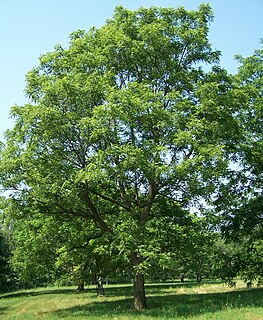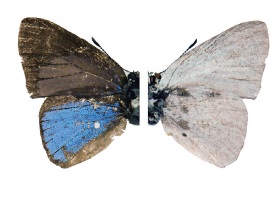
Walnut trees are any species of tree in the plant genus Juglans, the type genus of the family Juglandaceae, the seeds of which are referred to as walnuts. All species are deciduous trees, 10–40 metres (33–131 ft) tall, with pinnate leaves 200–900 millimetres (7.9–35.4 in), with 5–25 leaflets; the shoots have chambered pith, a character shared with the wingnuts (Pterocarya), but not the hickories (Carya) in the same family.
A walnut is the nut of any tree of the genus Juglans.

Juglans nigra, the eastern American black walnut, is a species of deciduous tree in the walnut family, Juglandaceae, native to North America. It grows mostly in riparian zones, from southern Ontario, west to southeast South Dakota, south to Georgia, northern Florida and southwest to central Texas. Wild trees in the upper Ottawa Valley may be an isolated native population or may have derived from planted trees.

Juglans regia, the Persian walnut, English walnut, Carpathian walnut, Madeira walnut, or especially in Great Britain, common walnut, is an Old World walnut tree species native to the region stretching from the Balkans eastward to the Himalayas and southwest China. It is widely cultivated across Europe.

Cryptocarya is a genus of evergreen trees belonging to the laurel family, Lauraceae. The genus includes more than 350 species, distributed through the Neotropical, Afrotropical, Indomalayan, and Australasian realms.

Endiandra is a genus of approximately 100 species of plants, mainly trees, in the laurel family Lauraceae. They are commonly called "walnut" despite not being related to the Northern Hemisphere walnuts which are in the family Juglandaceae.
Corkwood is a common name of a number of plants:

Endiandra globosa is a medium-sized Australian rainforest tree. Despite the common name of black walnut, this tree is unrelated to northern hemisphere walnuts, and is a Laurel.

Endiandra floydii is a small-sized rainforest tree. Despite its common name, Crystal Creek walnut, this tree is unrelated to northern-hemisphere walnuts, and is a laurel. It is named after the Australian botanist, Alexander Floyd.

Alexander Geoffrey Floyd is an Australian botanist with an expert knowledge of rainforest plants, particularly the rainforest trees of New South Wales. He has worked with the New South Wales Forestry Commission, the Department of Forestry in Papua-New Guinea, and the National Parks and Wildlife Service of New South Wales. He helped create the North Coast Regional Botanic Garden at Coffs Harbour. Two genera and several species of plants are named in his honour; including Floydia, Alexfloydia, and Endiandra floydii.

Endiandra pubens is a rainforest tree growing in eastern Australia. The habitat is subtropical rainforest growing near streams in valleys. The range of natural distribution is from the Bellinger River, New South Wales to Bulburin National Park, south west of Gladstone, Queensland.

Endiandra discolor is an Australian tree, growing from near Gosford, New South Wales to Tully, Queensland in the tropics. Common names include rose walnut and domatia tree.

Endiandra virens is an Australian tree in the laurel family. Growing from Boorganna Nature Reserve north west of Taree, New South Wales to Kin Kin in Southern Queensland. Common names include White Apple, Plumwood, and New South Wales Walnut.

Endiandra hayesii is an Australian rainforest tree. Despite the common name of rusty rose walnut, this tree is unrelated to northern hemisphere walnuts, and is a laurel. The former habitat is lowland sub tropical rainforest, most of which has been cleared. However some trees persist in cool sheltered gullies as far south as the Richmond River, New South Wales to just over the border at Burleigh Heads in Queensland. The rusty rose walnut is considered rare, with a ROTAP rating of 3RC-. It is named after H.C. Hayes, who collected this species at Minyon Falls.

Endiandra introrsa is a rare rainforest tree growing in eastern Australia. Listed with a Rare or Threatened Australian Plants (ROTAP) rating of 3RCa. Its habitat is warm temperate rainforest on the poorer rainforest soils, mostly over 300 metres in altitude, and its range of natural distribution is from near Dorrigo to various sites in the state of Queensland.

Endiandra muelleri subsp. bracteata, is a rare rainforest tree growing in eastern Australia. Listed as endangered by extinction. It is a subspecies of the tree known as green-leaved rose walnut, or Mueller's walnut, Endiandra muelleri. It occurs from Maclean, New South Wales to Mackay, Queensland, usually in sub tropical rainforest at the lower altitudes.

Philiris fulgens, the purple moonbeam, is a species of butterfly of the family Lycaenidae. It is found in Indonesia, New Guinea and Australia.
White apple is a common name for several flowering plants, neither in the apple/rose family, Rosaceae, and may refer to:
Rose walnut is a common name for several flowering plants in the family Lauraceae, in a different family and order from true walnut trees, and may refer to:













